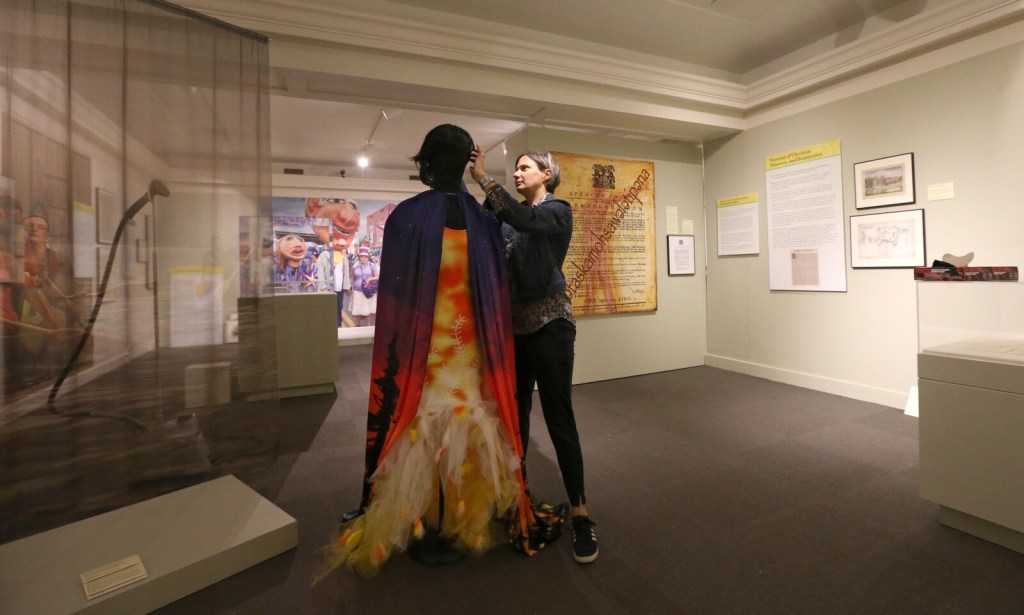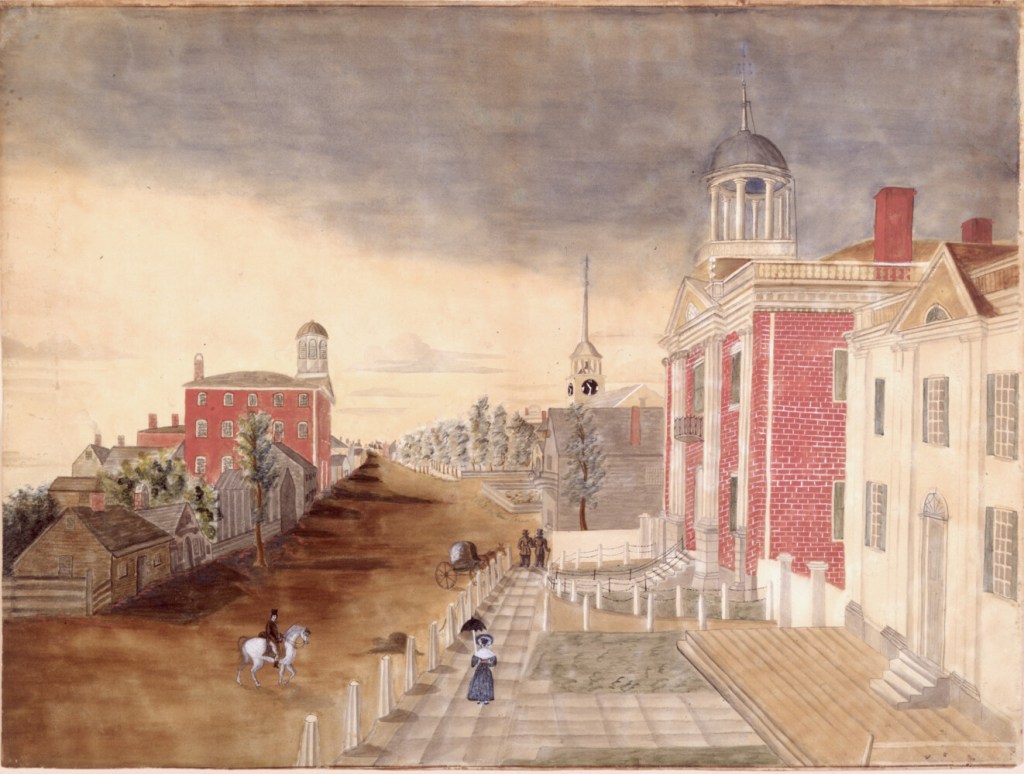With the arrival of Statehood Month and plans well underway for a grand Statehood Day celebration next Sunday in Augusta, excitement is building for all things recognizing Maine’s bicentennial year.
Across the state, Mainers are hosting and planning programs and events to mark the state’s separation from Massachusetts in 1820. Some are as simple as bicentennial bean suppers scheduled in many communities next weekend. Others are more momentous, including major exhibits opening this week at the Maine Historical Society and the Maine State Museum that explore a diverse and complex heritage 13,000 years in the making.
Bicentennial enthusiasm is mounting. More than 70 people of all ages gathered at the South Portland Public Library one evening last week for “Maine at 200: A Visual History,” an illustrated talk by Libby Bischof, a history professor and executive director of the Osher Map Library at the University of Southern Maine.
In the audience was Barbara Dow Nucci, a retired history professor with a growing knowledge of her Maine ancestors, some of them shipbuilders and sea captains who arrived in the late 1700s. In recent weeks, Dow Nucci has been poring over ancient family letters, journals and other records that breathe life into the men and woman who came before her.
“The bicentennial has inspired me to spend more time with them,” said Dow Nucci, 77, referring to both the documents and her ancestors. “They’re a treasure. I’m getting to know them better as individuals and as people who helped to bring us to statehood. I hope the bicentennial inspires others to learn about Maine history and their connections to it.”
Also at the South Portland talk was Juliette Sutherland, 30, a documentary filmmaker. Sutherland decided to attend the evening presentation after seeing a public notice. She was unaware that 2020 is Maine’s bicentennial year until she arrived at the lecture.
“I love history. I moved to Maine a couple years ago, and I wanted to dig into the history of Maine,” Sutherland said. “I’m definitely interested in the bicentennial now, and I plan to learn more about it.”
David Cheever has witnessed the increasing excitement firsthand. The former state archivist is vice chairman of Maine’s Bicentennial Commission.
Cheever has been planning for the bicentennial for more than a decade. He’s overseeing the Statehood Day celebration at the Augusta Armory and reviewing grant applications for $500,000 in state funding for bicentennial programs. Eligible groups may receive $500 to $10,000 to support classroom programs, poetry readings, musical performances and other events throughout 2020. Applications have been flowing in.
“It isn’t just history buffs who are excited about the bicentennial,” Cheever said. “It’s people who are recognizing and taking pride in their state and their communities in various ways.”

“We Walk On; Eternally,” a contemporary piece by multimedia artist James Eric Francis Sr. of the Penobscot Nation, is part of “State of Mind: Becoming Maine,” a major bicentennial exhibition opening March 13 at the Maine Historical Society. Ben McCanna/Staff Photographer
The Statehood Day celebration is open to all free of charge. Starting at 1 p.m., it will include musical performances, poetry readings and speeches from Gov. Janet Mills, Maine’s congressional delegation, Wabanaki leaders, State Historian Earle G. Shettleworth Jr. and Maine Poet Laureate Stuart Kestenbaum. The U.S. Postal Service will unveil Maine’s bicentennial stamp, and Hannaford will provide birthday cake.
Other major events this year include the State of Maine Bicentennial Parade through Auburn and Lewiston on May 16, the Maine Bicentennial Sailing Ships Festival June 25-July 19 and an Innovation Expo and statewide Grand Finale Weekend Oct. 9-12.
“It’s been a hoot,” Cheever said of planning bicentennial events. “It’s my idea of the perfect job. It’s not just a commemoration of Maine becoming a state. It’s an expression of us as diverse people and who we envision ourselves to be.”
Maine became an independent state on March 15, 1820, following years of political dissent and passage of the Missouri Compromise. The controversial federal legislation admitted Maine as a free state and Missouri as a slave state. It also divided the Louisiana Territory into free and slave-holding areas and laid the dividing line for future free and slave states.
Maine’s fraught entry into statehood is but one complicated aspect of the past that’s getting a fresh look 200 years later. Many bicentennial programs and events are recognizing the persecution, subjugation and exclusion of native Wabanaki, black people, women and others throughout Maine history, including ties to the slave trade.
That tangled history is highlighted in two major bicentennial exhibitions opening this week: “State of Mind: Becoming Maine,” opening Friday at the Maine Historical Society in Portland; and “Regional Struggle-National Story: Maine’s Path to Statehood,” opening Saturday at the Maine State Museum in Augusta.
The museum exhibit “takes a fascinating look at Maine’s part in the slave trade and shows the dilemmas faced by Maine people who, because of the Missouri Compromise, were forced to choose between independent statehood and the expansion of slavery in the United States,” said Bernard Fishman, museum director.
The society’s exhibit builds on its 2019 offering, “Holding up the Sky,” which explored indigenous Wabanaki philosophies of leadership and obligation through 13,000 years of living in the region now called Maine.

Gov. William King (1768-1852), Maine’s first governor, held office in 1820-21. A Bath resident, King was instrumental in the fight for statehood. This tintype image, likely made about 1865, is believed to be a copy of a daguerreotype made about 1845. Collections of Maine Historical Society
“State of Mind” features more than 150 documents, artifacts and images, both historic and contemporary. It includes a room furnished as it would have been in 1820 and an 1865 tintype of Gov. William King, Maine’s first top elected official.
It also includes “Évangéline,” a giant papier-mâché head made by Melanie Bourque of Madawaska. Worn in Acadian heritage parades, the “grosse tête” is named for the fictional heroine of Henry Wadsworth Longfellow’s poem about the mass deportation by the British of French Acadians from the Canadian maritime provinces and northern Maine in the mid-1700s.
Then there’s “We Walk On; Eternally,” a new multimedia work by Penobscot artist James Eric Francis Sr. The work highlights a 1755 proclamation that offered hefty bounties to English settlers for “pursuing, captivating, killing and destroying” all indigenous Penobscots.
Tilly Laskey, curator at the Maine Historical Society, worked with various groups represented in the exhibit to ensure it includes diverse perspectives. The result, she said, has been one of the most satisfying experiences of her career.
She hopes “State of Mind” inspires people to take a broader view of Maine’s past, present and future.
“I think visitors will be surprised by the cutting-edge subjects and objects we chose to understand statehood beyond the separation of Maine and Massachusetts,” Laskey said.
Send questions/comments to the editors.




Success. Please wait for the page to reload. If the page does not reload within 5 seconds, please refresh the page.
Enter your email and password to access comments.
Hi, to comment on stories you must . This profile is in addition to your subscription and website login.
Already have a commenting profile? .
Invalid username/password.
Please check your email to confirm and complete your registration.
Only subscribers are eligible to post comments. Please subscribe or login first for digital access. Here’s why.
Use the form below to reset your password. When you've submitted your account email, we will send an email with a reset code.